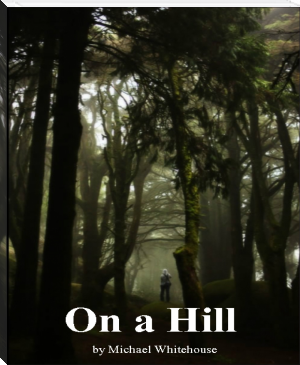Tunnels, Michael Whitehouse [tohfa e dulha read online txt] 📗

- Author: Michael Whitehouse
Book online «Tunnels, Michael Whitehouse [tohfa e dulha read online txt] 📗». Author Michael Whitehouse
l once knew a man who was afraid of nothing. No monstrosity man made nor fictitious could subdue his spirits, and the mere mention of the word 'supernatural' would elicit a most cynical example of laughter. This bravery was both his greatest strength and his most profound weakness, for ignorance and heedlessness can often be mistaken for a deep and foolhardy sense of courage. He was to learn the limits of his bravery down in those oppressive tunnels, deep below the streets of Amsterdam.
His name was Henke, due mainly to his Finnish ancestry on his father's side, and although his parents had passed away at an early age, it was clear that he believed his courageous convictions could be attributed to his father's character.
I had met Henke four years earlier while travelling with some friends on a rather common rites of passage: Backpacking through Europe during a university break. He and a few of his friends were on a similar trip and happened to be staying at the same youth hostel as myself and my companions in Rome. We all got on well, but both Henke and I struck up an immediate rapport with one another as he was a keen musician and I was at the time still filled with the self promise, or should I say delusion, of stardom through my own musical pursuits.
This friendship continued onwards and we maintained it via email; swapping musical discoveries, talking about politics, and generally getting to know one another as best two people can through simple correspondence. I grew to enjoy our friendly debates over the years and on a few occasions we even visited one another. Henke moved around a lot and as such it gave me a good excuse to visit a number of mainland European countries, not to mention that he always knew which local pubs served the best beer and which restaurants were to be best avoided.
Last year I visited Henke in Amsterdam. The Dutch city seemed to be a good fit for him as he always liked to live in the liveliest of places, and with countless meandering canals, bridges, and walkways swamped with millions of tourists every year, Amsterdam, for Henke, felt like the very embodiment of life and vibrancy. At the time he had been recently hired to carry out some important maintenance work on the Rijksmuseum, which is one of Amsterdam's most impressive buildings, and this seemed to have rooted him to the one place for longer than was usual.
When I met him in a small darkened corner of a local pub, well away from the burgeoning tourist trade, I was shocked at his appearance. Here was a friend I had grown to know as being larger than life, exuding bravado, and yet I was presented with a shell of a man, slight in stature and racked with self doubt.
He proceeded to impart on me the circumstances which resulted in his precarious condition, of which I will relay to you now.
Henke had been working as a civil engineer for some time and relished the challenge of renovating and maintaining the Rijksmuseum, a building with such a long and compelling history. The museum houses Amsterdam's finest collection of historical relics, and being given access to some of its more hidden places which are inaccessible to the general public, piqued Henke's fascination for the obscured and unique.
He had been hired most specifically to lead a maintenance crew which had been assigned to assess and repair the building's foundations. This oldest part of the structure dated back centuries and had a most bizarre and, it must be said, quite horrific history. The Rijksmuseum itself had been constructed in 1885, but what it had been built upon possessed a much older and interesting history.
In the bowels of the building under its marble floors and deep red brickwork, lay a labyrinth of abandoned tunnels which at one time served as part of the old city's sewer network. They had long been disused and fallen into disrepair but they were nonetheless an essential part of the building's foundations and had to be assessed and repaired, otherwise the entire structure would be in danger of subsiding.
The ground and upper levels of the museum were beautiful and displayed many wonderful historical relics from all over the world. So welcoming and warm was the atmosphere of the building that it was difficult to imagine the darkness which festered below. After some quick words with the building manager, Henke proceeded to an old, seldom used room at the back of the museum which housed a rather antiquated, creaking, and cage-like elevator which was being used to access the lower levels and sewers underneath.
Pulling on a pair of dirt covered yellow overalls, complete with hard hat and head lamp, Henke entered the elevator for his first descent. On his trip downwards towards the abandoned sewers, Henke thought to himself that those of a nervous disposition may let such a dank and isolated place prey on their minds. This may have explained why the previous man in charge of the repairs had left so abruptly, citing nervous exhaustion and refusing to ever so much as set foot in those pitch black corridors of cold stone ever again.
The elevator winch and engine stuttered as it lowered Henke down four levels into the basement. With each passing floor he observed a slight dimming of the lights and each subterranean level appeared more sparse, and stone-like than the one before. A rusted plate attached to the elevator betrayed its age. It struck Henke that the year of its construction, 1932, must have been amongst the last periods of maintenance carried out there before the persecution of the Jewish people and the outbreak of war in Europe.
Henke knew much of the shameful history of the region as he was part Jewish and his great Grandfather had died during the holocaust. Many had fled to Amsterdam for sanctuary from the Nazi regime in the early 1930s, but the long blighting arm of Hitler's horrific 'final solution' eventually reached the borders of Holland, sweeping many thousands away to those shameful and barbaric concentration camps.
The elevator shuddered to a halt and after forcing the rusted sliding door aside, Henke disembarked. The tunnels - comprising Amsterdam's disused sewer network - were curious in construction and steeped in a history which stretched back much farther into the distant past than that of the museum itself. Having spoken to his employers, Henke had been specifically told to pay heed to the assessment and repair crews' knowledge of the tunnel layout, as the place could be disorientating and as the lighting system required to illuminate repair work had not been fully installed yet, that he would find it all too easy to get lost.
Most importantly Henke was informed that the two-way radios normally used to communicate between team members had been playing up, and that they were very unreliable due to interference, probably produced by nearby metallic deposits in the ground. This meant that communication between his team members would have to be carried out verbally, or by using the light from their torches to convey simple messages via Morse code; this was particularly useful in the longer tunnels. In any case, it struck Henke that the catacombs below really were isolated, lonely places.
Care must be taken.
Henke was greeted by Jones, his second in command. Jones was a substantially stout fellow and was rather humorous in nature. He debriefed Henke on the current progress being made by his new team, informing him that the initial mapping and assessments of the tunnels had gone well. All in all there were 16 four man crews, each of which would be assigned a section of the sewers to repair. Henke would supervise two of the crews which were working in one of the more isolated tunnels.
After walking for 15 minutes Henke arrived at the area which would be his workplace for the next few months. The sound of occasional drilling could be heard in the distance as the workers continued to install the still non-operational lighting system. As Henke's men would be working further away from the other crews, it seemed logical - although not desirable - that they would have a lighting system installed last.
Each passageway seemed oddly shaped with no two tunnels being quite alike, this entire section of the sewer was in fact so antiquated that it had been built long before the careful planning of such constructions had become commonplace. One tunnel would arch onwards for over several hundred metres in a strange semi-circle, while others bisected it at right angles, carrying on in a regimented straight line into the darkness. Henke even found a passageway which seemed to dip and rise only to slither its way along in an unnatural S-shape. Some tunnels seemed to go on forever, others stopped abruptly as if the original builders had been unable to complete their work, leaving in a hurry. Jones tried to keep the conversation light and with his experience of walking through the tunnels for the past two months, Henke was glad to have a guide to show him the way.
Waiting in a large alcove were four of Henke's team. They would work this section of the tunnels during the day, while the other shift would take over later, working through the night. Jones introduced each of them. They seemed nice enough, but Henke was surprised to find the men largely in the grips of silence. In his experience humour was normally found in abundance, with repair crews using it to slice through the monotony of working in such cramped and repetitive conditions. Here though, he found them uttering not one word, sitting in silence in that imposing alcove, removed from any consideration of camaraderie or fellowship; the only inference that they were not a collection of subterranean statues was the occasional movement of their head lamps altering the shadows around them.
They seemed wholly disconnected from, not just each other, but the very environment in which they worked.
Henke brushed this feeling of unease aside and committed himself to cultivating conversation; if these men were in some way angry or uncomfortable with one another then Henke would soon lay that to rest; a happy workforce is a productive one.
The first order of business was to survey this section of tunnels and decide where repairs were most pressing. Preliminary assessments had already been made, but Henke liked to evaluate any repair project he was involved in from the ground up. Henke walked the catacombs with his team and noticed immediately that they were still on edge, that they seemed frightened in an almost childlike way. No amount of questions casual or otherwise could elicit anything other than one word broken replies. As they toured the numerous tunnels, lighting their way with the small torches attached to their safety helmets and taking notes about failing walls, water damage, and estimations of any possible repair time, Henke pressed the men on their obvious sense of fear, asking why such an experienced crew who no doubt had worked in many tunnels before, were so apprehensive of mere bricks and mortar.
They avoided the questions, looking nervously at one another and changing the topic of conversation with mono-toned lethargy whenever it veered towards their experiences of the old sewers, or of their previous boss's unceremonious departure from the job. It began to dawn on Henke that the men's verbal and physical awkwardness was not the result of tensions between workers, but rather of a deep seated and worrying apprehension; of what he did not know. What was clear was that his team seemed to be counting down the minutes until their shift ended, when they could finally clamber out of the darkness into the safety of the world above.
As the





Comments (0)